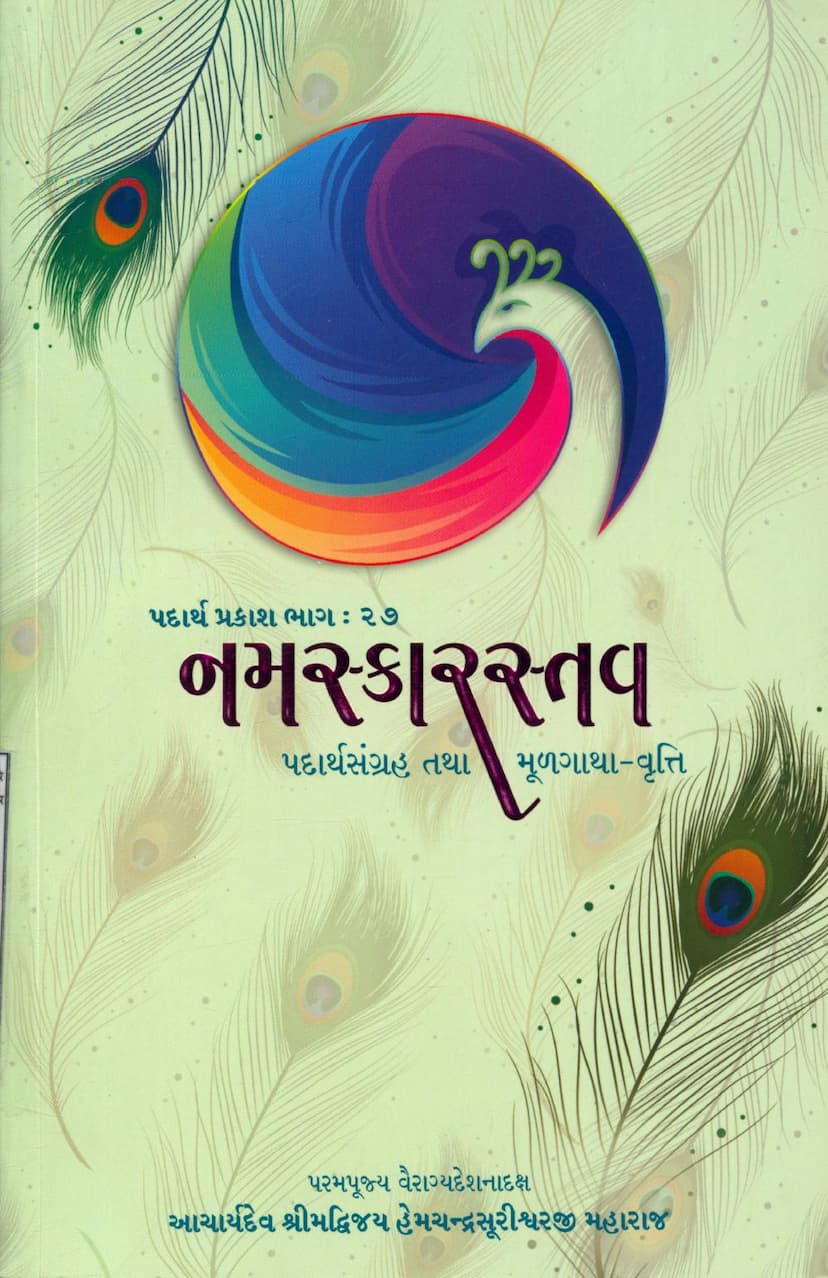Padarth Prakash 27 Navkar Stava
Added to library: September 2, 2025

Summary
Here's a comprehensive summary of the Jain text "Padarth Prakash 27 Navkar Stava" by Vijayhemchandrasuri, based on the provided pages:
Book Title: Padarth Prakash Part 27 - Navkar Stava: Padarth Sangrah and Mool Gaatha Vritti Author(s): Primarily based on the work of Jinakirtisuri, with compilation and editing by Acharya Shri Mad Vijay Hemchandrasuri. Publisher: Sanghvi Ambalal Ratanchand Jain Dharmik Trust Catalog Link: https://jainqq.org/explore/032796/1
This book is a scholarly exploration and compilation of "Navkar Stava," a significant Jain text attributed to Jinakirtisuri, along with his commentary. The work focuses on the mathematical and enumerative aspects of the Navkar Mahamantra.
Core Content and Subjects:
The primary aim of this book is to provide a detailed analysis and compilation of the Navkar Mahamantra from a numerical and combinatorial perspective, as originally presented by Jinakirtisuri in his "Navkar Stava" and its commentary. The book delves into the following five key subjects:
-
Number of "Bhangas" (Arrangements/Permutations) of the Nine "Padas" (Terms) of the Navkar Mahamantra: The text explains how to calculate the total number of possible arrangements of the nine terms of the Navkar Mahamantra. This involves understanding permutations and factorials. The calculation for nine terms yields 3,62,880 "bhangas."
-
Expansion (Prastar) of the Bhangas: The book details the methods for systematically listing and generating these numerous "bhangas." It presents two primary methods for this expansion:
- First Method (Sequential Placement): This method involves a step-by-step process of placing numbers in a sequence, often involving careful consideration of avoiding repetition and managing remaining digits.
- Second Method (Divisional and Rotational): This method is more complex, involving the division of the total number of permutations by the last digit, then dividing the result by the second to last digit, and so on, to determine "parivartankas" (rotation factors) for each position. These factors are then used to arrange the numbers in specific rows.
-
Finding a "Bhanga" from its Serial Number (Bhanga Kramank): This section explains how to determine a specific arrangement (bhanga) if its serial number is known. It involves a reverse calculation process using the divisor factors (parivartankas) and their relationships with the digits and their positions.
-
Finding the Serial Number from a "Bhanga": Conversely, this explains how to calculate the serial number of a given arrangement. This involves understanding the contribution of each digit in its position based on the divisor factors and summing them up, adding one at the end.
-
The Significance (Mahima) of Calculating Anupurvi, Ananupurvi, etc.: The book highlights the importance and benefits of understanding and calculating these various arrangements. It states that by properly understanding and meditating on these "bhangas," one can achieve spiritual liberation and overcome obstacles. Specific benefits mentioned include the destruction of sins, warding off calamities, attainment of prosperity, achieving spiritual powers, and even the binding of Tirthankar karma through dedicated chanting.
Key Features and Structure:
- Compilation and Commentary: The book is a compilation of Jinakirtisuri's "Navkar Stava" and his Sanskrit commentary. Acharya Vijay Hemchandrasuri's contribution lies in compiling and editing this work, making it accessible.
- Mathematical Focus: The text is heavily based on mathematical principles, particularly combinatorics and permutations, applied to the Navkar Mahamantra.
- Detailed Examples and Tables: The book includes numerous examples and extensive tables (especially in the appendices) demonstrating the calculation and listing of "bhangas" for up to five terms, and providing a starting point for nine terms.
- Appendices: The book features three appendices:
- Appendix 1: Contains a substantial list of "bhangas" for nine terms, starting from serial number 1. The author notes that listing all 3,62,880 bhangas would be too extensive, so it provides a guide and the beginning of the list.
- Appendix 2: Includes the original "mool gaathas" (verses) of the "Navkar Stava."
- Appendix 3: Provides an alphabetical index of the "mool gaathas."
- Emphasis on the Navkar Mahamantra's Power: The introductory and concluding sections strongly emphasize the immense spiritual power and benefits of reciting the Navkar Mahamantra with devotion, faith, and concentration. It is described as the greatest mantra, capable of destroying sins, removing obstacles, and bestowing various siddhis and worldly happiness.
- Methodology: The book elaborates on methods for determining "parivartankas" (rotation factors) which are crucial for generating the arrangements. It also explains how to handle "samayabhed" (avoiding digit repetition) during these calculations.
- Historical Context: Jinakirtisuri is mentioned as a disciple of Somasundarsuri, and his commentary was composed in Vikram Samvat 1494 (1437-1438 CE).
In Essence:
"Padarth Prakash Part 27 - Navkar Stava" is a specialized Jain text that delves into the intricate mathematical permutations of the Navkar Mahamantra. It serves as a detailed guide for understanding the calculation, generation, and significance of these arrangements, often referred to as "bhangas." The work honors the original composition by Jinakirtisuri and makes its complex mathematical concepts accessible through the compilation and editing efforts of Acharya Vijay Hemchandrasuri. The book ultimately aims to deepen the reader's appreciation for the Navkar Mahamantra and encourage its devotional practice, highlighting its profound spiritual benefits.